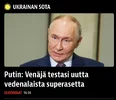Situation in the Pokrovsk area, Part III.
Information arriving yesterday and today from the Pokrovsk area indicates that the Ukrainian command of the 7th Corps, initiated approximately a week ago, attempted to stabilize the city's defenses based on the railway line, has failed. Russian assault groups are penetrating further north, both in the area of the road to Pavlohrad (48.293887, 37.126165) and the adjacent industrial district, as well as north of the railway station within the 8th district (48.295010, 37.186230).
The railway line was the last natural defensive line from which Ukrainian troops could still defend themselves in the city. Since deploying larger reserve forces into the very narrow isthmus currently separating the Pokrov Agglomeration from the rest of Ukraine is impossible – due to the Russian air superiority of the Rubicon drone group – the Ukrainian General Staff "East" command has practically run out of options to improve the operational situation. Thus, everything indicates that the battle for the Pokrov Agglomeration is entering its final stage.
In recent days, the Special Operations Command (DS) has finally awakened from its slumber and begun updating the map in the Pokrov area, slowly making up for weeks of delays. Suddenly, it turned out that "the Zverovo area is a weak point in the Ukrainian defense," which the enemy exploited to penetrate deeper into the city. In fact, the Russians breached the defense lines of the 32nd Air Base there around the end of September, and they had been penetrating even earlier, since mid-September. A similar situation occurred in the area of Chervony Lyman and the Rodyńskie-Pokrovsk intersection with the road to Hryshine (48.32307, 37.20346). Fierce fighting for the area has been ongoing since early September 2025. During these battles, the Ukrainians lost more than a dozen combat vehicles and MRAPs, as well as several dozen soldiers, in counterattacks, only to be able to halt the advance of the 9th Rifle Brigade (Zmot), which was attacking there. The Soviet Defense Forces (DS) began gradually marking the advance of Russian troops in the Chervonograd Lyman area on their map only in the last few days.
This can be continued in the deconstruction of the Soviet Defense Forces (DS) and profiles like Osman, Officer, etc., which, a few days ago – just after the publication of an article in Ukrainska Pravda presenting the actual situation in Pokrovsk – suddenly discovered that the situation there was critical. "Worst of all, the enemy has managed to disrupt logistics towards Myrhorod and the entire urban area. In addition to infantry ambushes, enemy drones are actively operating, monitoring and striking movements towards positions, supplies, etc.," the Soviet Defense Forces (DS) wrote today.
Except that the exact same thing could be heard in a front-line report by Slidstvo on Tube from September 18th, which I wrote about at the time. The soldiers of the 68th Yager Brigade, who spoke there, were already saying that Rubicon controlled the skies over Pokrovsk and all roads leading to it from the Shevchenko-Hryshine direction – which were at the Ukrainian disposal – using FPV drones and larger Molnya-type attack drones. Access to the city by car was already practically impossible. The report went unnoticed because Bankova was in the middle of creating a media spin called "big Russian cauldrons near Dobropol" so that Zelensky could boast about allegedly encircling 1,000 Russian soldiers during a conversation with Trump, and this could not be interrupted.
In summary, the "advice" published today in a long DS post entitled "What needs to be done to save Pokrovsk" is obviously at least a month late, and the people in this analytical group are well aware of this. They only serve to maintain credibility in the "we warned you" style.
/SPOILER]








